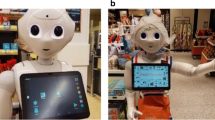Abstract
We developed a modular robotic tile and a system composed of a number of these modular robotic tiles. The system composed of the modular robotic tiles engages the user in physical activities, e.g., physiotherapy, sports, fitness, and entertainment. The modular robotic tiles motivate the user to perform physical activities by providing immediate feedback based upon their physical interaction with the system. With the modular robotic tiles, the user is able to make new physical set-ups within less than a minute. The tiles are applicable for different forms of physical activities (e.g., therapeutic rehabilitation), and with the proper radio communication mechanism they may give unique possibilities for documentation of the physical activity (e.g., therapeutic treatment). A major point of concern in modular robotics is the connection mechanism, so we investigated different solutions for the connection between the modules, and outline their pros and cons for utilizing modules with different connection mechanisms as different kinds of playware. This kind of playware is highly motivating because of its immediate feedback and fun, interesting games.
Similar content being viewed by others
References
Lund HH, Klitbo T, Jessen C (2005) Playware technology for physically activating play, Artif Life Robotics J 9(4):165–174
Heart news (2007) Hjerteforeningens medlemsblad Hjertenyt, 4 (in Danish)
Robotic therapy tiles help patients play their way to health. Wired, 02/10/2007 http://www.wired.com/medtech/health/news/2007/10/therapy_tiles (Accessed 30 October 2008)
Lund HH, Vesisenaho M (2004) I-blocks in an African context. Proceedings of the 9th International Symposium on Artificial Life and Robotics (AROB’9), ISAROB, Oita, pp I-7–I-12
Lund HH, Marti P (2005) Designing manipulative technologies for children with different abilities. Artif Life Robotics J 9(4):175–187
Nielsen J, Lund HH (2003) Spiking neural building block robot with Hebbian learning, Proceedings of the IEEE International Conference on Intelligent Robots and Systems (IROS2003), IEEE, Las Vegas, pp 1363–1369
Grönvall E, Marti P, Pollini A, et al (2006) Active surfaces: a novel concept for end-user composition. Proceedings of the 4th Nordic Conference on Human-Computer Interaction: Changing Roles. NordiCHI’ 06, vol 189, ACM, New York, pp 96–104
Hayes R, Parkes A, Ishii H (2004) Topobo: a constructive assembly system with kinetic memory. Proceedings of the SIGCHI Conference on Human Factors in Computing Systems, Vienna, Austria, ACM, Vienna, pp 647–654
Zuckerman O (2004) System blocks: learning about systems concepts through hands-on modeling and simulation. Masters Thesis, MIT
Richardson B, Leydon K, Fernstrom M, et al (2004) Z-Tiles: building blocks for modular, pressure-sensing floor spaces. In: CHI’ 04 Extended Abstracts on Human Factors in Computing Systems. CHI’ 04. ACM, New York, pp 1529–1532
Author information
Authors and Affiliations
Corresponding author
Additional information
This work was presented in part at the 13th International Symposium on Artificial Life and Robotics, Oita, Japan, January 31–February 2, 2008
About this article
Cite this article
Lund, H.H., Dam Pedersen, M. & Beck, R. Modular robotic tiles: experiments for children with autism. Artif Life Robotics 13, 394–400 (2009). https://doi.org/10.1007/s10015-008-0623-4
Received:
Accepted:
Published:
Issue Date:
DOI: https://doi.org/10.1007/s10015-008-0623-4




